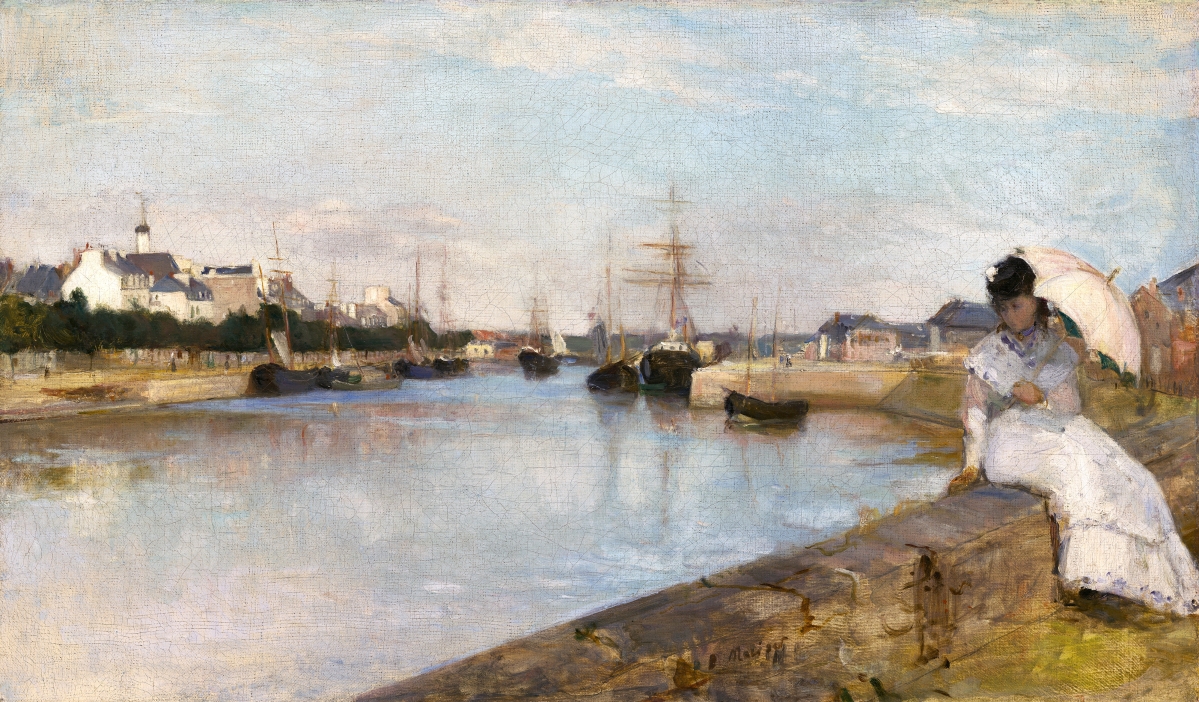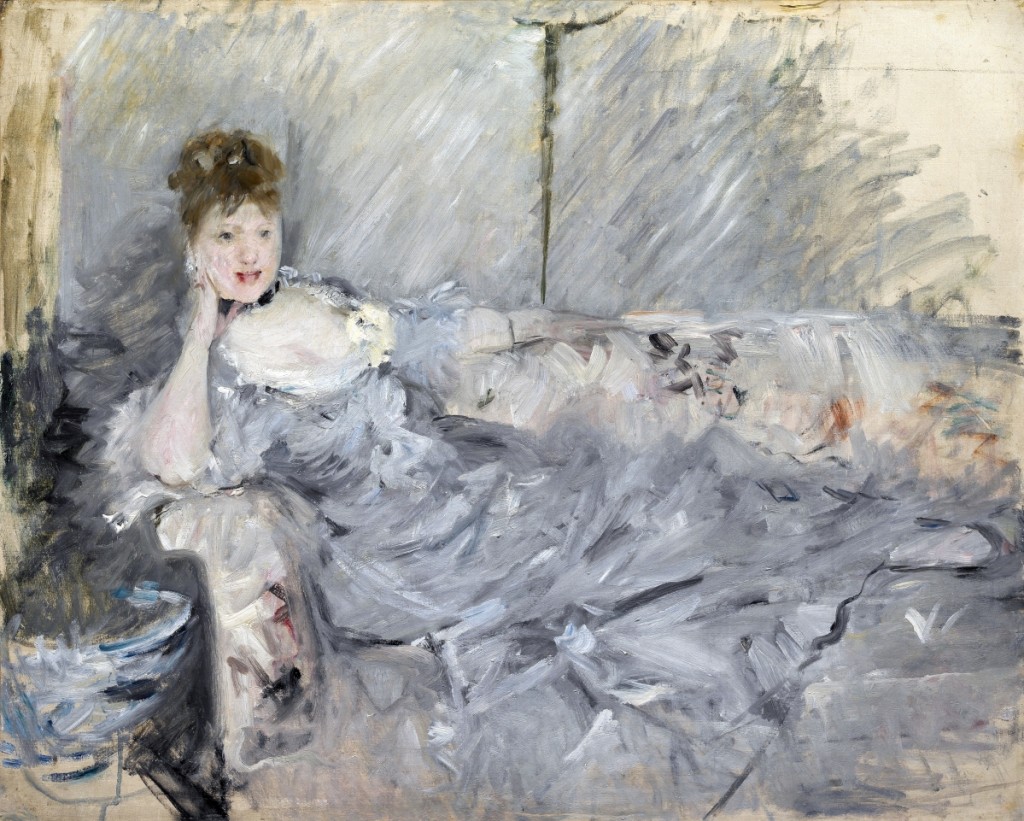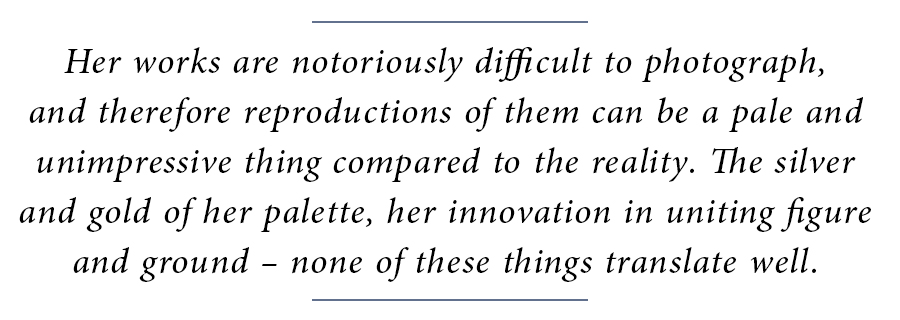
“The Harbor at Lorient (Seascape)” by Berthe Morisot, 1869. Oil on canvas. National Gallery of Art, Washington, DC, Ailsa Mellon Bruce Collection. Photo courtesy of National Gallery of Art.
By Jessica Skwire Routhier
DALLAS – “Berthe Morisot: Woman Impressionist,” which opened at the Musée national des beaux-arts du Québec and traveled to the Barnes Foundation in Philadelphia before arriving at its current venue, the Dallas Museum of Art, has drawn considerable attention from the American press. Perhaps unsurprisingly, given our currently heightened sensitivities about issues of gender, nearly every reviewer has questioned the wisdom of the title: why put “Woman” in it? Stephen Salisbury of the Philadelphia Inquirer focused on this in an article titled, “Calling Berthe Morisot a ‘woman impressionist’…grates on the ears of artists and museumgoers.” To do so, complainants argue, is unnecessary at best and marginalizing at worst.
But Nicole Myers, curator of European painting and sculpture at the Dallas Museum of Art, explains that the title was carefully considered and chosen despite the expected blowback. “One of the things we noticed here in the United States is that Berthe Morisot is not a well-known name at all,” adding that many “don’t even know that it’s a woman’s name.” The organizers, she said, wanted to use the title “to really be able to tell who she is but also explain why you haven’t heard of her.” Ultimately, this is the more interesting question that the exhibition gives us to ponder: why haven’t more of us heard of her? What are the reasons for her near-erasure from the canon of art history? With a deep dive into Morisot’s figure paintings, the culture in which they were produced, and the biography of the woman who created them, these are the more substantive questions that “Berthe Morisot: Woman Impressionist” attempts to discern. It is on view at the Dallas Museum of Art through May 26.
The answers are not as simple as “because she was a woman;” the ready retort to that position is to simply say, “Mary Cassatt.” Nevertheless, more often than not, the answers that do emerge are connected to Morisot’s gender in some way. As an example, we can look to the way that Western art history developed throughout the Twentieth Century, with a heavy focus not only on a modernism that was perceived as leading directly to pure abstraction but also on white male practitioners of that modernism. This left some gifted and important artists entirely out in the cold, but for those like Morisot, who arguably fit into one category but not the other, it meant second-tier status. The study of Impressionism was particularly dogmatic in this way, with early historian Camille Mauclair (a man, despite the gender-bending name) identifying a “glorious quartet of masters” – Édouard Manet, Edgar Degas, Claude Monet and Pierre-Auguste Renoir. Everyone else was seen as occupying a lower rung – even brilliant technicians like Gustave Caillebotte, even Camille Pissarro, the only Impressionist who exceeded Morisot’s own record of commitment to the Impressionist movement (he showed in all eight exhibitions; she showed in seven). If Cassatt seems to break the surface of this B-list, it is primarily for American audiences, by whom she, an American herself, was especially beloved.
The present exhibition is not the first effort to restore Morisot to the canon where she belongs – for she does indeed belong there. As co-curator Sylvie Patry’s catalog essay outlines, feminist art historians began to study Morisot in the 1970s, leading eventually to her first major retrospective, titled simply “Berthe Morisot: Impressionist,” in 1987, and Anne Higonnet’s influential 1990 biography. Such efforts put Morisot on the map with art historians but not necessarily with the general public. “That earlier exhibition was the last monographic exhibition” until this one, notes Myers, and while she has no words of criticism for the show itself, she regrets that it “didn’t do the job that we hope this exhibition will do, which is really draw attention to who she was while exploring some of the reasons that she is less familiar.” In this context, it is possible to appreciate how the insertion of the word “woman” into the title is an attempt to hone and revitalize the goals of those earlier efforts. In this age of #MeToo, there is a renewed realization that we are still waiting for the promises of second-wave feminism to come to full fruition, in art historical scholarship as much as anything else. For Myers, who was a student of the redoubtable feminist art historian Linda Nochlin (author of Why Have There Been No Great Women Artists?), both the mission and the terminology are clear choices.
So how does Morisot’s gender intertwine with her erasure from the art-historical canon? In many ways, she was fortunate, having been born into an affluent family that valued the arts. With a sister close to her age she was also able to attend private art classes, since the young women could act as each other’s chaperones. The Morisot parents even built their daughters a home studio and allowed them to sell their work and compete for exhibition spots at the Paris Salon. But Morisot soon tired of creating the kind of art that young ladies were expected to do – small flower studies and pastel landscapes – and was increasingly drawn to the art of the avant-garde, whose members rebelled against the slick, historicized aesthetic of academic French painting. Like them, Morisot wanted to create paintings of modern life and to experiment with color and form and brushwork in ways that were entirely new. By 1869, Morisot’s sister had married, moved away, and given up painting (“The Cradle” shows Edma Morisot with her firstborn); by 1874, Morisot was exhibiting with the Impressionists at their first breakaway exhibition. She was at the very front of the vanguard and in complete control of her own career.
Myers observes that Morisot soon developed a style that critics of her time found impossible to ignore. “Whether they loved or hated it, they always commented on her style,” Myers says. “She developed a particular mastery of how she applied white paint especially… [they] couldn’t help but compliment the effect that she is able to conjure through the most minimal means and the bold application of paint.” Morisot also developed something of specialty that uniquely suited her gifts. Her paintings of “Parisiennes” – the archetypal young, affluent, modern women of Paris, much like Morisot herself – are like showpieces for what Myers calls Morisot’s “silvery palette” and her pioneering work in blending together figure and background: “Woman at her Toilette,” a series of shimmering whorls and diffused reflective surfaces, and “Woman in Gray Reclining,” an animated tone poem in which the boundaries between dress, couch, and wall all but disappear, are key examples.
While others also used the subject of the Parisienne, Morisot made it her calling card, in part because of the success she had with it, but also because she was, to a large degree, limited to it. As a woman, she had been barred from admission to the École des Beaux-Arts and had no opportunity to study from the nude figure; she also had to grapple with the limitations she had as a woman of a certain class. Not only could she not frequent the bars and clubs of the demimonde, where her male colleagues gathered to discuss art and conduct the business of their field, but she also was limited even in the kinds of outdoor experiences she could have. Upper-class women simply could not go out alone: the pleasant idyll that we see in Morisot’s “Reading (The Green Umbrella)” could only have happened within the confines of a private estate. Hence, perhaps, the infrequency of landscapes in Morisot’s oeuvre, or their limitation to very public promenades like the Trocadéro or the seawall at the resort town of Lorient. Given these limitations, says Myers, “it’s no small thing that she managed to develop this incredible talent, exhibit with her male peers and get better reviews than the bulk of them.” Not only that, Myers points out, but she was legitimately a pioneer in modernist French figure painting, being one of the first, if not the first, to paint bathers at their toilette, which became a staple of the era.
There are facts about Morisot’s life, too, that undoubtedly affected the perception of her work in her time and beyond. In 1874, she married Eugène Manet, the brother of Édouard Manet, one of the “glorious quartet” of French Impressionists. From that point forward, she had to battle both conscious and unconscious perceptions of her as “Manet’s sister-in-law,” perhaps accompanied by some belief that it was only through his influence that she was successful – when in fact, she exhibited and sold her work long before her marriage, and was fully a part of the Impressionist circle in her own right, as no one’s appendage. But the misperception may have been made more difficult to dispel by the fact that she also served frequently as Manet’s model, posing for his masterpiece “The Balcony,” among other works.
Like many female artists who succeeded her, including Georgia O’Keeffe and Frida Kahlo, she became known just as much, then and now, for her striking face as for her work. There is no evidence that she objected to Manet’s depiction of her as a Parisienne herself, well-dressed and as willing to be observed as to observe. But her own self-portraits, including one from 1885, with her painting palette in hand, and the one that graces the cover of Higonnet’s 1990 book, dressed all in black and half in shadow, provide evidence that she saw herself differently.
There were also aspects of how she conducted her career that were mixed blessings in terms of her legacy. As a woman of means, both before and after her marriage, she was not dependent upon the sale of artworks to make her living (as Patry points out, this alone did not fit into the dominant art-historical narrative of artists as “fighters struggling against the poverty and adversity of their times.”) Because of this, she never established the kind of art dealer relationship that other modernists did. Myers notes that after her death, somewhere around 80 percent of her work went directly to her family. Much of it remains in private hands; 60 percent of the exhibition are loans from private collections, including “Woman in Gray Reclining” and her late, vaguely Symbolist portrait of her daughter, Julie. So the reality is that many art historians have seen Morisot’s work primarily in reproduction and not in the flesh. “If professors and students of art history are not seeing her works,” Myers says, “maybe they’re not going to think about betting on her.”

“Woman in Grey Reclining” by Berthe Morisot, 1879. Oil on canvas, private collection. Photo by Christian Baraja.
Herein lies yet another possible reason for Morisot’s erasure from art-historical memory: her works are notoriously difficult to photograph, and therefore reproductions of them can be a pale and unimpressive thing compared to the reality. The silver and gold of her palette, her innovation in uniting figure and ground – none of these things translate well. “The DMA’s ‘Winter'” – a portrait of a woman holding a fur muff – “photographs as this really ugly dirty green brown,” says Myers, “but when you stand in front of it, it is the most golden, shimmering winter scene.” The camera, Myers says, just can’t capture the layers of Morisot’s glazes and how they reflect the light. This is partly why she hopes that as many people as possible will go to see the exhibition in one of its four venues (it will travel to Paris’ Musée d’Orsay, where Patry is now deputy director of curatorial affairs and collections, after the Dallas venue) – to escape that flattening effect.
“Flattening” is as good a word as any to characterize the historical difficulty in approaching Morisot and her work on their own terms. Some have accused the present exhibition of doing just that by including “Woman” in the title, arguing that to do so is reductive and encourages a misperception that she is only worthy of consideration because she is a woman. I am sympathetic to this view, but I do not agree with it. One of the features of art history as it developed in the Twentieth Century was not only to enshrine a relatively small group of male artists, as we have discussed, but also to argue for a criticism in which the subject matter or any circumstances that accompanied the work’s creation were either irrelevant or far less important than the formal qualities of line, space and color. “Berthe Morisot: Woman Impressionist” explodes both of those mythologies, both by celebrating the work of this first-tier French Impressionist and by looking at it and her from a 360-degree view, remediating the erasures and omissions of the past.
The Dallas Museum of Art is at 1717 North Harwood Street. For information, 214-922-1200 or www.dma.org.


_1875.jpg)


_1894_oil_on_canvas_private_collection.jpg)














